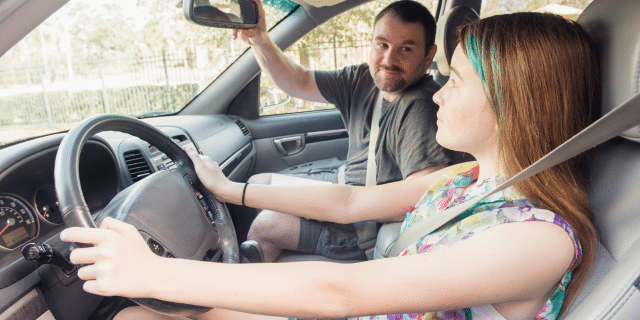The freedom of summer is calling, and for many teens, that means hitting the road—often for the first time without a parent in the passenger seat. With new jobs, beach days, late-night hangouts, and spontaneous road trips on the agenda, it’s easy to forget that driving comes with serious responsibility. For parents, this season is a crucial time to set clear expectations behind the wheel. From curfews to passengers to phone use, establishing ground rules now can help your teen build smart habits that last far beyond the summer.
Follow intermediate licensing laws in your state.
Most states have graduated driver licensing (GDL) programs designed to help teens gain experience behind the wheel while minimizing risks. These often include rules like curfews, limits on passengers, and restrictions on highway driving. Start by familiarizing yourself with your state’s laws at www.ghsa.org. Then, build on those requirements with your own family rules. For instance, you might allow only daylight driving for the first month, then gradually expand driving privileges as your teen demonstrates responsibility.
Establish a nighttime curfew.
Driving at night is inherently more dangerous due to decreased visibility and increased likelihood of encountering impaired drivers. Teens, who are still developing experience and judgment, are especially vulnerable. Even if your state allows nighttime driving, consider setting a curfew that keeps your teen off the road during high-risk hours—often between 9 p.m. and 6 a.m. You might also require that they log a certain number of supervised nighttime hours with you before being allowed to drive alone after dark.
Ban cell phone use while driving.
Distracted driving is a leading cause of accidents, and teens are especially susceptible. While some states ban any cell phone use for drivers under 18, it’s smart to create a zero-tolerance rule at home regardless of local laws. That means no texting, no scrolling, and ideally, no hands-free calls unless absolutely necessary. Consider installing monitoring apps that block texts and calls while driving, and most importantly, model good behavior yourself—your teen is watching.
Talk about speeding—and how to avoid it.
Speeding contributes to nearly a third of all fatal teen crashes. Stress the importance of following posted speed limits, adjusting for weather conditions, and maintaining safe following distances. Teach your teen the three-second rule for following other vehicles, and how to give extra space to large trucks. Encourage them to build in extra time when leaving for work or social plans so they’re never tempted to rush.
Enforce seat belt use—every ride, every time.
Seat belts save lives, plain and simple. Make it a non-negotiable rule: the car doesn’t move until everyone is buckled up. Remind your teen that they are responsible for their passengers’ safety, too. Unbelted passengers can become deadly projectiles in a crash—even in the back seat.
Address impaired driving before it happens.
Teens may face peer pressure to drink or ride with someone who’s been drinking. It’s essential to talk openly about these situations and offer a safe exit plan. Let your teen know they can always call you for a ride—no questions asked—if they’re ever in an unsafe situation. Emphasize that driving under the influence of any substance, including marijuana or even some medications, is never acceptable.
Teach basic car maintenance and awareness.
Being a safe driver also means being prepared. Make sure your teen knows how to check the gas gauge and fill up when needed—ideally before it dips below a quarter tank. Show them how to recognize warning lights, check tire pressure, and know what to do in case of a breakdown. A quick review of the vehicle’s manual can go a long way in empowering your teen behind the wheel.
Know your teen’s driving plans.
As your teen begins driving independently, stay in the loop. Ask them to let you know where they’re going, who they’ll be with, and when they plan to return. If plans change, they should update you before getting behind the wheel again. Keeping control of the car keys is one way to ensure that you stay informed.
Put it in writing.
Consider drafting a parent-teen driving agreement that outlines the rules and consequences clearly. This written commitment can serve as a helpful reminder and a great conversation starter. It also opens the door for regular check-ins to reassess the rules as your teen gains experience. Be sure to revisit the agreement periodically, especially if any violations or concerns arise.
Don’t forget the insurance.
Before your teen starts driving, make sure they are properly insured. In some cases, good student discounts and safe driving programs can help lower costs. Most importantly, you want to be sure your teen is covered in the event of an accident.
Summer driving can be a rite of passage for teens—and a nerve-wracking time for parents. But with the right rules and a foundation of open communication, you can help your teen navigate this new freedom safely. Remember, driving is a privilege that comes with responsibility. By setting clear expectations and modeling safe behavior yourself, you’re laying the groundwork for a lifetime of smart driving choices.
This article is furnished by California Casualty, providing auto and home insurance to educators, law enforcement officers, firefighters, and nurses. Get a quote at 1.866.704.8614 or www.calcas.com.
- You were probably raised by a nurse if… - November 30, 2025
- Stress Management Tips for Police Officers - November 26, 2025
- Helping Your Dog Lose Weight - November 21, 2025

